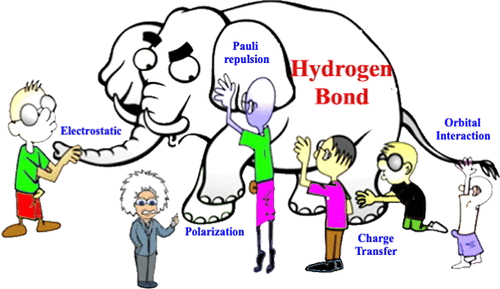JACS: Study on the nature of hydrogen bond interaction with valence bond theory
Published Time: 2024-08-01 14:49:06

The nature of hydrogen bonding plays a vital role in understanding the
structure and properties of substances, the mechanism and trend of chemical
reaction processes, and therefore has been widely studied by experimental and
theoretical chemists. Valence bond theory provides intuitive chemical
understanding and new perspectives to weak interactions (including hydrogen
bonding), and related works can be found in the following articles published by
our team:
Recently, Sason Shaik from Hebrew University and coworkers applied the
valence bond theory to the study of nine hydrogen bond systems, including (F---H–F)-, (HO---H–OH)-, (CN---H–NC)-, (NC---H–CN)-, H2CO---H–NH2, H2O---H–OH, H3N---H–CF3, HF---H–F and H3N---H–F.

The calculation results show that the
hydrogen bond interaction is dominated by polarization (ΔEPOL) and
charge transfer (ΔECT). In different energy decomposition analysis
(EDA) methods, which of these two interactions dominates the strength of
hydrogen bond is inconsistent; however, the sum of these two terms for different
hydrogen bond systems obtained by valence bond theory shows the same trend as
the results obtained by various EDA methods.
This study provides a new understanding of the nature of hydrogen bond
interactions through the calculation of valence bond theory, that is, polarization
and charge transfer are entangled in hydrogen bond interactions, and their
relative values may be interdependent.
It is also found that the covalence-ion resonance energy (charge transfer energy) of the hydrogen bond is in linearly with the dissociation energy of the corresponding hydrogen bond. This means it is possible to indirectly evaluated the strength of hydrogen bond by experiments via measuring the dissociation energy of the hydrogen bond.
The analysis of valence bond wave function shows that the ionic structure of hydrogen bond system enhances the electropositivity of hydrogen bond acceptor compared with free water molecules. In the case of water dimers, the ionic structure enhances the electric field of the O−H bonds outside the water cluster, leading to an unexpected REDOX reaction and contributing to the catalytic reaction of water droplets and water-hydrophobic interfaces.
Reference:
Valence BondTheory Allows a Generalized Description of Hydrogen Bonding
Sason Shaik,* David Danovich, and Richard N. Zare*
XACS Research Highlights
XACS Research Highlights are posts about examples of research carried out using the XACS platform. We welcome the users to submit their blog posts to us at xacs@xmu.edu.cn or directly to one of the PIs and we will highlight your research on the official XACS channels and social accounts. We reserve the right to small editorial changes for clarity and corrections.